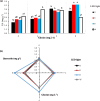Enhancing the accumulation of scopolamine and atropine in Hyoscyamus niger L. callus by LED light and glycine-a cheap method
- PMID: 40885905
- PMCID: PMC12398075
- DOI: 10.1186/s12870-025-07062-z
Enhancing the accumulation of scopolamine and atropine in Hyoscyamus niger L. callus by LED light and glycine-a cheap method
Abstract
Background: The production of tropane alkaloids such as atropine and scopolamine by chemical methods is costly. This study aimed to find a more efficient method for producing tropane alkaloids by investigating different LED light qualities and glycine treatment using leaf callus cultures of Hyoscyamus niger L. in vitro.
Results: In this study, after producing healthy plantlets, callus induction was done in the B5 medium with 2-4-D (2,4-Dichlorophenoxyacetic acid) at 2 mg L-1 with BA (6-benzyl adenine) at a concentration of 1 mg L-1. The use of LED light and glycine treatments started from the callus stage, in such a way that the callus produced was placed in culture media containing different concentrations of glycine (0, 2, 4 and 8 mg L-1). They were transferred to light boxes, and light treatments were applied at 4 levels (darkness (D), white LED light (WLED), blue LED light (BLED), and red LED light (RLED)). The results demonstrate that, glycine had a significant impact on the accumulation of total carbohydrates and total amino acids, quercetin, total phenols and total flavonoids in H. niger L. callus under LED light qualities. The highest atropine was obtained under Blue LED (BLED) conditions with the glycine at mg L-1, while the highest scopolamine was observed under BLED conditions with glycine at 4 mg L-1. Also, the highest gallic acid levels (4.18 mg g-1) were observed in callus grown under BLED and RED LED (RLED) light conditions with glycine at 8 mg L-1.
Conclusion: In the present study, we have developed an efficient protocol for the production of tropane alkaloids by investigating different LED light colors and glycine treatments exploiting in vitro callus cultures of H.niger. These findings could have potential applications in the pharmaceutical and food industries for efficiently producing high-valued alkaloids from the plants.
Keywords: Hyoscyamus niger; Atropine; Glycine; LED light quality; Scopolamine.
© 2025. The Author(s).
Conflict of interest statement
Declarations. Ethics approval and consent to participate: All methods performed in this study including the plant tissue culture were in compliance with the relevant institutional, national, and international guidelines and legislation. Consent for publication: Not applicable. Competing interests: The authors declare no competing interests.
Figures










Similar articles
-
Prescription of Controlled Substances: Benefits and Risks.2025 Jul 6. In: StatPearls [Internet]. Treasure Island (FL): StatPearls Publishing; 2025 Jan–. 2025 Jul 6. In: StatPearls [Internet]. Treasure Island (FL): StatPearls Publishing; 2025 Jan–. PMID: 30726003 Free Books & Documents.
-
Calcium and silicon nanofertilizers improved morphological attributes and fatty acid composition in olive; an insight to synergistic interaction between these elements.BMC Plant Biol. 2025 Jul 31;25(1):997. doi: 10.1186/s12870-025-07027-2. BMC Plant Biol. 2025. PMID: 40745585 Free PMC article.
-
The quantity, quality and findings of network meta-analyses evaluating the effectiveness of GLP-1 RAs for weight loss: a scoping review.Health Technol Assess. 2025 Jun 25:1-73. doi: 10.3310/SKHT8119. Online ahead of print. Health Technol Assess. 2025. PMID: 40580049 Free PMC article.
-
Conservation of Verbascum sinaiticum Benth using innovative tissue culture technique and DNA barcoding.Sci Rep. 2025 Jul 18;15(1):26075. doi: 10.1038/s41598-025-10968-1. Sci Rep. 2025. PMID: 40681695 Free PMC article.
-
The Black Book of Psychotropic Dosing and Monitoring.Psychopharmacol Bull. 2024 Jul 8;54(3):8-59. Psychopharmacol Bull. 2024. PMID: 38993656 Free PMC article. Review.
References
-
- Abbasi BH, Tian C-L, Murch SJ, Saxena PK, Liu C-Z. Light-enhanced caffeic acid derivatives biosynthesis in hairy root cultures of Echinacea purpurea. Plant Cell Rep. 2007;26:1367–72. - PubMed
-
- Acharjee S, Kumar R, Kumar N. Role of plant biotechnology in enhancement of alkaloid production from cell culture system of Catharanthus roseus: a medicinal plant with potent anti-tumor properties. Ind Crop Prod. 2022;176: 114298.
-
- Adil M, Ren X, Jeong BR. Light elicited growth, antioxidant enzymes activities and production of medicinal compounds in callus culture of Cnidium officinale Makino. J Photochem Photobiol B. 2019;196: 111509. - PubMed
-
- Ahmadianfar S, Mehrabi N, Mohammadi S, Sobhanizadeh A, Moradabadi A, Noroozi-Aghideh A. Effects of horsetail, alfalfa, ortie, chêne and Aleppo oak as potential hemostatic agents on laboratory coagulation tests. Nat Prod Sci. 2023;29(1):42–9.
-
- Al Murad M, Razi K, Jeong BR, Samy PMA, Muneer S. Light emitting diodes (LEDs) as agricultural lighting: impact and its potential on improving physiology, flowering, and secondary metabolites of crops. Sustainability. 2021;13(4):1985.
MeSH terms
Substances
LinkOut - more resources
Full Text Sources

